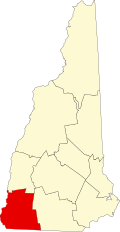Description and history
The Richard Strong Cottage is located on the north side of Gowing Lane, a now dead-end lane that was historically part of the main highway between Dublin and Peterborough (now bypassed by New Hampshire Route 101). It is a modest 1+1⁄2-story frame structure, with a gabled roof, central chimney, and clapboarded exterior. It has a five-bay front facade, with sash windows arranged symmetrically around the entrance. The entrance is flanked by sidelight windows and topped by a modern Federal style wooden fan. [2]
This house was probably built c. 1767 by Silas Strong, one of Dublin's first settlers, as it sat on land he originally owned. It was reconstructed near its current site c. 1805 by Captain Richard Strong, whose house stands nearby. The two houses frequently had shared ownership. Strong gave this house to his daughter and son-in-law, Mary and Jonathan Smith, in 1844, and it was sold out of the family by 1880. It was moved a few hundred feet east, to its present location, in 1980, at which time a small ell was removed. [2]
This page is based on this
Wikipedia article Text is available under the
CC BY-SA 4.0 license; additional terms may apply.
Images, videos and audio are available under their respective licenses.



